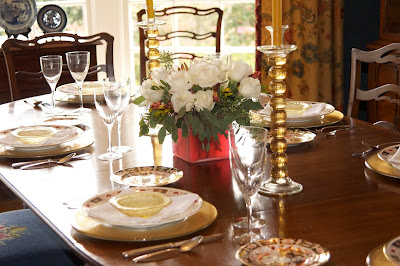When it comes to decorating, little things make a big difference. The perfect room can be ruined by little things just as the perfect outfit can be ruined by the wrong pair of shoes or the wrong purse. (I realized the other day that I had run out of the house in a red dress with my hot pink purse, it wasn't pretty.) So here are the most common mistakes do-it-yourself decorators make, in no particular order.
1. Hanging Artwork

When you go to the theater to see a movie,
do you enjoy sitting in the front row? Probably not, considering that by the
closing credits you’ll have a crick in your neck. Many people hang their artwork high enough to give the average person a sore neck. Art should generally be hung at eye level. And unless you are going for the art gallery look, the art should relate to something else in the room. This can mean making the art part of a grouping or having a consistent color scheme or style. Also, every wall does not have to have something hung on it! Hanging art on some walls distracts the eye from what you really want people to focus on: your beautiful space.
2. Wrong Paint Colors
There is a reason builders paint house interiors beige, it is neutral and safe. Many people live with it because they don't know what else to do, but rarely is the random color already on the walls the right color to show your room to its best advantage. Do you have the color you want or did you go with the "safe" choice? The right wall color can add drama to a room or be the perfect back drop for showing off your furnishings.
3. Wrong Scale or Bad Proportions
Good scale and proportion may be hard to describe or quantify but you know it when you see it. We've all seen the room with the too big TV, or the huge couch with the tiny coffe table or (one of my pet peeves) a tiny rug in a big space. Decorators take years training their eye to understand proportion and scale. It can be a hard thing to get right.
4. Poor Furniture Arrangements
The mistake I see the most with furniture arranging is shoving all the furniture against the walls. Furniture needs to be considered as part of a group and not a stand alone item. Just about everyone knows a coffee table is usually placed in front of a couch but it should be 18 - 24" in front of the couch, not three feet away. How can you put down a drink or put up your feet if the coffee table doesn't relate to the couch? Don't put your big comfy chair 8 feet from the couch either unless you want the person sitting in the chair to feel like he or she is in a time out.
5. No Window Treatments or Bad Window Treatments
Windows are a great way to bring architecture and light to a room. The right treatment can enhance a beautiful window or disguise a poorly placed one. It is hard to get a beautiful window treatment without investing a little money. This is one place where quality really makes a difference. Knowing where to hang your covering is also important. This comes back to proportion and scale. Many homeowners don't know what length of window treatments they need or how high to hang them.
6. Poor Quality
Quality shows, and it’s better to have one or two good
pieces than a room full of cheap ones. Buying an inexpensive sofa and chairs may seem like a good deal in the short term but a good sofa or chair is worth reupholstering and can be altered if styles change. A cheap sofa will end up on the curb. Quality will hold up and hold value. The good news is quality isn't always expensive. If you are willing to buy things second hand you can get solid wood furniture for the price of new particle board pieces. Grandma's furniture is often better made than much of the furniture sold today.
7. Buying In Sets
My last
piece of advice is don’t buy sets for
your room. It’s easy to go to a showroom and get a “room to go”. You can check
everything you need off a list: a bed, nightstands, a dresser, a mirror, but where’s the creativity in that? Your room becomes as matchy as a
hotel room, or as staged as a showroom. It shows nothing about the person
living there. A room should say something about who you are.
If you think you are guilty of making some or all of these mistakes, remember, I am only a phone call away.
A LITTLE FLUFF. . .
This month, my daughter and oldest child graduated from college with a degree in Graphic Design. I am very proud of her and all she has accomplished and am excited to see where life takes her next. She and her fellow graduates have many joys, challenges and milestones ahead.
Many other parents have celebrated graduations this spring. My prayer is that we, as parents, have prepared these graduates to meet life's challenges with courage, dignity and integrity. I hope my daughter knows that her value lies in who she is and not what she looks like; in what she gives to the world and not what she acquires; that no one is always right and that she can admit it when she is wrong; and that being right is not as important as being kind. Most of all, I hope she knows that she is loved.











































